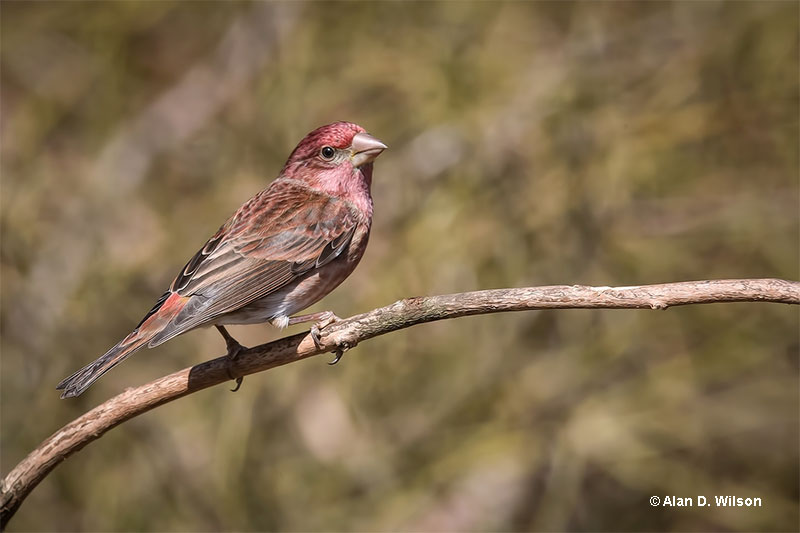
New Hampshire is a small state in New England with 9,349 square miles of beautiful forest, farms, and other natural habitats. The Granite State is also home to nearly 1.4 million people and more than 425 bird species!
The New Hampshire state bird is the Purple Finch. This beautiful raspberry-colored bird is a common sight throughout the state!
On this page
The State Bird of New Hampshire
The Purple Finch became the state bird of New Hampshire on April 25, 1957. On this day, the state of New Hampshire legislature finally voted to accept this beautiful little finch to represent the state.
Although most states picked their official birds in the 1930s, New Hampshire didn’t choose one until the 1950s. The process was a bit delayed due to lack of initiative and because some state legislators wanted to pick the American Crow or the Blue Jay!

Originally, state legislators wanted to name the American Crow as the state bird.
Although both those species are very common birds in New Hampshire, local birders, nature groups, and other organizations believed that the Purple Finch would be a far better choice.
This pretty bird is frequently heard and seen in every corner of New Hampshire. It’s also more common in New Hampshire than in most other states.
To ensure the Purple Finch was chosen to represent New Hampshire, the State Federation of Women’s Clubs, the Audubon Society of New Hampshire, and other clubs joined forces. They campaigned and lobbied the legislature until an official vote was held to choose the Purple Finch.
Although they still had to convince one legislator who wanted to choose the New Hampshire Hen, he eventually realized that the native Purple Finch was a much better choice!
Fun Facts about Purple Finches
- In some parts of eastern North America, the closely related and more aggressive House Finch has been replacing the Purple Finch. The House Finch can outcompete Purple Finches in parks and other urban settings.
- Purple Finches don’t eat flowers, but they often feed on nectar. They crush the flower with their beak to squeeze out and reach the nectar.
- This species sometimes mimics other birds. The male Purple Finch includes bits and pieces of their vocalizations in its song. Some of the more commonly mimicked species are American Goldfinches, Barn Swallows, and Brown-headed Cowbirds.
- Once in a while, Purple Finches migrate well south of their usual range during the winter. Like other finches and birds, they do this when their usual food sources become scarce. They migrate until they find suitable food, including seed at bird feeders!
- The Purple Finch is known as a seed predator. While some animals and birds accidentally help plants by distributing seeds, Purple Finches eat and destroy the seeds.
- New Hampshire is the only state that has the Purple Finch as its official bird.
Identification
Purple Finches are small, sparrow-sized birds with strong, conical beaks. These pretty birds are around the same size as a House Sparrow (6 inches), have a 10-inch wingspan. They weigh around 0.88 ounces.
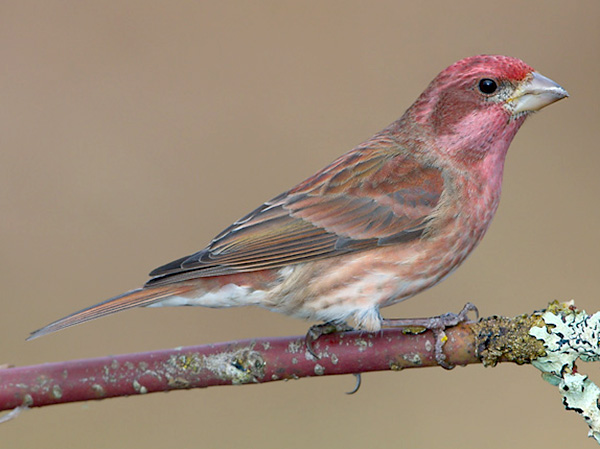
Photograph © Glenn Bartley.
Male Purple Finches are lovely raspberry red or wine-colored birds with brighter colors on their head and chest. The rest of their underparts are white, and they have a pale mark in front of their eye. These handsome finches also have a dusky red area on their face, dusky streaks on their back, and a few thick raspberry streaks on their flanks.
Related: 17 finch species you can see in the U.S.
Their long wings have two pale reddish wing bars, and feathers with dark edging. Purple Finches also have a medium-length, forked tail.
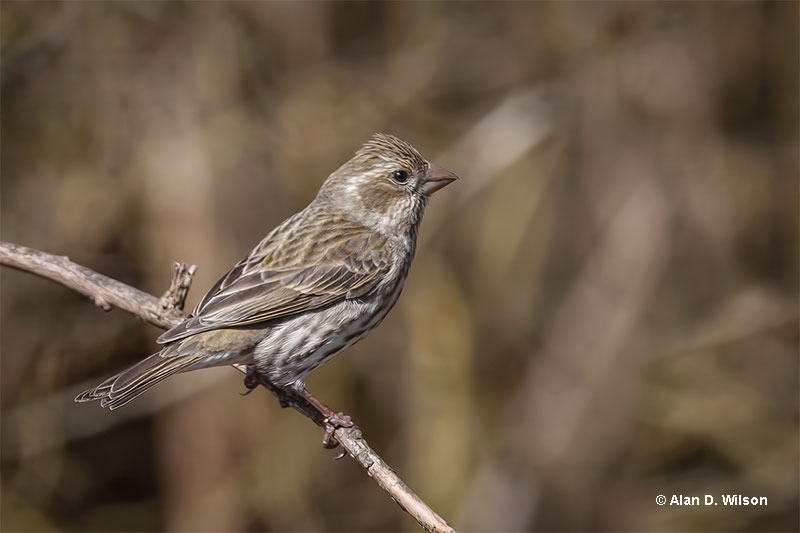
Female Purple Finch
Female Purple Finches look very different from males. They have dark streaks on white underparts, two pale wing bars, and a streaked back.
In general, they look like a sparrow with gray-brown streaks, broad pale eyebrows, and a dark patch on their face. Females also have a small pale spot in front of their eyes.
This species often forms small flocks, especially in winter. They fly with undulating flight and often call. When flying, we can also see pale pink on the male’s underwings, and buff on the female’s underwings.
What do Purple Finches eat?
Purple Finches feed on a variety of seeds, tree buds, flower nectar, fruit, and some insects. They eat all sorts of seeds, including those of Elms, Sycamores, Junipers, and Mountain Ash. This species can also take seeds from Red Cedars, Ragweed, Poison Ivy, and many other plants.
In addition to feeding on seeds, Purple Finches also eat a variety of fruits. Some of the more commonly eaten ones are crabapples, hackberries, raspberries, blackberries, and sumac. While feeding on seeds and fruits, during spring and summer, they won’t hesitate to take buds and get nectar from flowers.
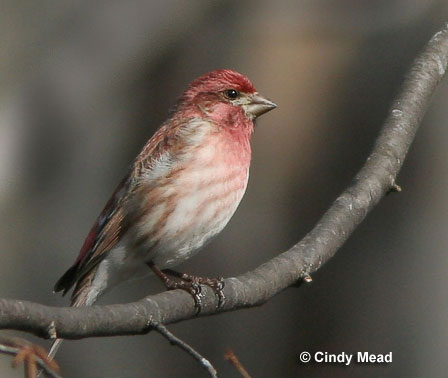
They obtain nectar by using their strong beak to squeeze the base of the flower and drink the “extracted juice”! While foraging for seeds and fruits, Purple Finches perch and pick food with their beaks. They seem to have a preference for feeding on the outer branches of trees but can also forage in other places.
In spring and summer, this finch also catches some insects, mostly to feed their young. Much to the good fortune of bird lovers, these beautiful finches are also regular visitors to bird feeders. They have a strong preference for black oil sunflower seeds but will eat millet and thistle seeds.
Call
Purple Finches often make sharp “pik” and a short whistled call, “wheeyo”. They often make these calls when flying and this is a good way to know when Purple Finches have migrated to the neighborhood.
Male Purple Finches sing a melodious, short warbling song. It lasts about two seconds and can be a quick, slightly descending trill, or a more complex warbling song. This more complex song varies but sounds something like, “tiptiptiptitp chip chureeahreahrip”.
Behavior
Purple Finches live in coniferous and mixed coniferous forests in Canada, the northeastern USA, the Great Lakes region, and Pacific coastal forests from British Columbia to California.
In winter, we can also see them at feeders, sometimes as far south as northern Florida. However, this doesn’t happen every year.
In the breeding season, Purple Finches form pairs, and males are often seen singing from a high perch.
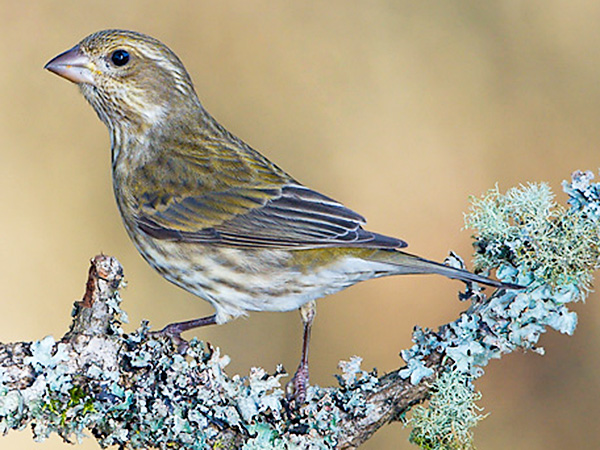
Female. Photograph © Glenn Bartley.
After pairing up, the female builds the nest on a branch under overhanging vegetation. She makes a deep, cup nest out of twigs, pine needles, and other bits of vegetation and lays 5 eggs.
After breeding, by fall, Purple Finches form small flocks. These groups of Purple Finches move around in search of fruiting and seeding trees and can also visit backyard bird feeders.
No matter what time of year, Purple Finches spend a lot of time foraging. We see them perched on the outer branches of trees and sometimes in lower seeding vegetation. Unlike warblers and other active insectivores, Purple Finches don’t move around as much.
They like to perch in one spot and pick seed after seed, berry, and flower bud. When feeding like this, bits of falling seed husks can reveal their presence.
Keep reading – most common birds of New Hampshire
New Hampshire State Bird – Frequently Asked Questions
What is the state bird of New Hampshire?
The state bird of New Hampshire is the Purple Finch.
Why is the Purple Finch the state bird of New Hampshire?
The Purple Finch is the state bird of New Hampshire because it is one of the state’s more common and beautiful birds.
When did New Hampshire choose its state bird?
New Hampshire chose its state bird on April 25, 1957.
What is New Hampshire’s state animal?
New Hampshire’s state animal is the White-tailed Deer.
What is the state flower of New Hampshire?
The state flower of New Hampshire is the Purple Lilac.

